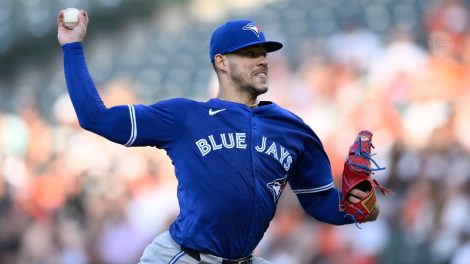DETROIT – The second half of the season was supposed to represent a fresh start for the Toronto Blue Jays, and it did for a game, before the frustrating losses kept coming.
This time, the Blue Jays overcame a poor start from Marco Estrada only to lose to the Detroit Tigers in walk-off fashion, 6-5 in 11 innings.
Even though Estrada didn’t make it out of the fourth, Justin Smoak, Kendrys Morales and Jose Bautista all homered and strong work from the bullpen kept the score close for a while. But J.D. Martinez homered off Danny Barnes in the eighth inning to tie the score, and Lucas Harrell walked Miguel Cabrera with the bases loaded in the 11th to win it for Detroit.
Three errors contributed to the frustration for the Blue Jays, who also allowed a catchable ball drop in right-centre field for a double.
“Really, the way we’ve been playing, we’re where we should be the way we’ve been playing in all phases of the game,” manager John Gibbons said. “A tough one today.”
The resulting loss means the Blue Jays lose their first series of the second half and fall to 42-49 on the season. While a playoff appearance remains technically possible, contending American League teams probably aren’t worried about the Blue Jays right now.
Among the reasons for the Blue Jays’ tough predicament: the continuation of Estrada’s struggles. In the first inning, Gibbons made a rare mound visit to deliver a message in person.
“I just thought he needed to cut the ball loose,” Gibbons said. “I didn’t think he was cutting the ball loose.”
Estrada improved from there, and didn’t allow another run until the fourth, when two fly balls fell in for consecutive doubles. His command wasn’t as sharp as he’d like, particularly when throwing his change-up, but he was pleased with how he rebounded from the first inning.
“I felt great,” Estrada said. “I felt like myself again. I thought I made a lot of good pitches … I’m looking back and other than (Justin) Upton’s hit in the first, I don’t remember too much being hit too hard, so I’m taking those positives with me.”
Still, Estrada continues to search for answers. In eight starts since June 1, he has allowed 38 earned runs in 36 innings. He has walked 26 over that span. And he has completed five innings in just two of those eight starts, taxing Toronto’s bullpen in the process.
[snippet id=3319157]
What makes those results more surprising is that his first two months of the season were so impressive. After 11 starts, Estrada had seemingly taken his game to another level, with a 3.15 ERA and 10.2 strikeouts per nine innings.
Compare the two stretches, and you notice a couple of differences. First off, Estrada has been throwing fewer strikes. Since June, 60 per cent of his pitches have been strikes, down from 68 per cent early in the season. That leads to more walks, high pitch counts and short outings.
“His location’s been off,” Gibbons said leading up to the game. “That’s vital to him. The change-up’s been up in the zone. That’s hurt him a few times, but nothing major or mechanical or anything like that.”
It’s perhaps more concerning that Estrada’s ability to suppress hits appears to have deserted him. From 2015-16, nobody allowed a lower batting average on balls in play than Estrada’s .224 mark. Not Jake Arrieta, not Clayton Kershaw, not Max Scherzer. Early in 2017, that trend held up, but from June 1 until the all-star break, Estrada allowed a .394 BABIP.
That increase can be partially attributed to the Blue Jays’ defence, which has regressed in 2017, but other factors may be involved, too. Determining what they are is the hard part. His velocity has been consistent – higher than it was last year, even. He continues to strike hitters out, with five more whiffs on Sunday.
Either way, the combination of more walks and more hits has led to an extended rough stretch for Estrada with no obvious way out. All told, he has a 5.33 ERA on the season, up from 3.13 in 2015 and 3.48 in 2016.
[relatedlinks]
Teams don’t judge players based on ERA anymore – Jose Quintana had far more trade value with a 4.49 ERA than Dan Straily does with a 3.40 mark – but the Blue Jays are in a difficult position now that one of their best potential trade chips has an ERA of 5.33 while another, Francisco Liriano, has a 6.04 ERA and a sore neck. These poor performances simultaneously strengthen the case for dealing pending free agents and reduce the front office’s options on the trade market.
There are still two weeks to go before the July 31 deadline, though. First, the Blue Jays continue a tough road trip through Boston and Cleveland after a disappointing start to the second half in Detroit.
“We didn’t play good enough ball,” Gibbons said. “That’s the bottom line.”









